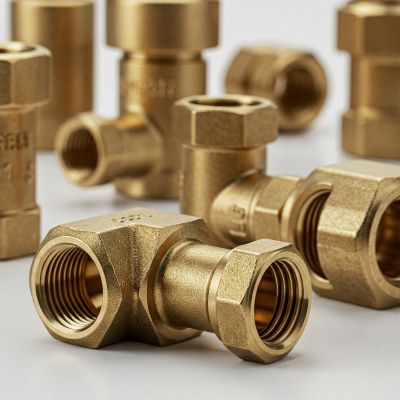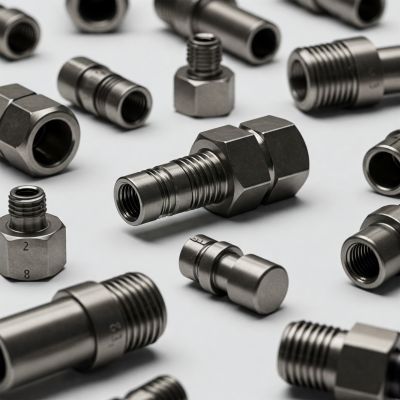Pipe threads are essential for secure and leak-free connections in industrial applications, including plumbing, gas, and hydraulic systems. Among the various thread standards, BSPT (British Standard Pipe Tapered) and RC (Tapered Pipe Threads, Japanese Standard) are two commonly used types that often confuse due to their similarities.
This guide will explain the key differences between BSPT and RC threads, their compatibility, and the best use cases to help you select the right option for your application.
What Are BSPT and RC Threads?
BSPT (British Standard Pipe Tapered) Threads
BSPT threads are part of the British Standard Pipe (BSP) thread system, primarily used in Europe and other regions. These threads are:
➡️ Tapered, meaning they gradually decrease in diameter along their length.
➡️ Designed to create a seal through thread interference, eliminating the need for washers or O-rings.
➡️ It is commonly used in gas lines, plumbing systems, and hydraulic fittings.
RC (Tapered Pipe Threads, Japanese Standard)
RC threads follow the Japanese Industrial Standard (JIS B0203) and are widely used in Japan and some parts of Asia. They are:
➡️ Equivalent to BSPT in thread design, as they share the same tapered profile.
➡️ Slightly different in tolerances and fit, which can affect interchangeability.
➡️ Used in various pipe fittings, hydraulic applications, and industrial machinery.
Key Differences Between BSPT and RC Threads
|
Feature |
BSPT (British Standard Pipe Taper) |
RC Thread (Rc) |
|
Thread Type |
Tapered male thread |
Tapered female thread |
|
Thread Profile |
55-degree included angle |
55-degree included angle |
|
Sealing Mechanism |
Self-sealing due to the taper |
Designed to mate with R threads for a self-sealing connection |
|
Application |
Primarily used in plumbing and hydraulic systems for pipe connections |
Used in conjunction with R threads for a secure and leak-proof connection |
|
Compatibility |
Mates with female BSPT threads (Rc) |
Mates with male R threads |
Thread Standards & Origins
➡️ BSPT: Defined under ISO 7-1, a globally recognized standard primarily used in Europe, the UK, and other regions.
➡️ RC: Defined under JIS B0203, mainly adopted in Japan and certain Asian markets.
Thread Angle & Profile
➡️ Both BSPT and RC threads share a 55° Whitworth thread form.
➡️ Despite this similarity, slight variations in tolerance and fit can affect compatibility.
Sealing Mechanism
➡️ Both BSPT and RC threads are tapered, creating a seal by metal-to-metal contact.
➡️ However, in certain applications, PTFE tape or thread sealant may be required to enhance sealing and prevent leaks.
Interchangeability & Compatibility
➡️ BSPT and RC threads are often interchangeable due to their similar design.
➡️ However, slight differences in thread tolerances may result in minor fitment issues, requiring proper checking before installation.
➡️ It is recommended to verify thread specifications and perform a test fit to ensure a secure connection.
How to Identify BSPT and RC Threads
To avoid misidentification and compatibility issues, follow these steps:
1. Measure Thread Diameter and Pitch
➡️ Use calipers or micrometers to measure the outer diameter (OD) of male threads and inner diameter (ID) of female threads.
➡️ Check thread pitch using a thread pitch gauge.
2. Check the Taper Angle and Thread Depth
➡️ BSPT and RC threads share the same 55° angle, but checking the exact taper and depth can help confirm compatibility.
3. Use Standard Thread Charts
➡️ Compare measurements against BSPT and JIS B0203 reference charts to determine the correct thread type.
BSPT vs. RC Threads: Selection Guide
When to Use BSPT vs. RC Threads
➡️ Use BSPT threads for applications in European and global markets where ISO 7-1 standards are required.
➡️ Use RC threads in Japanese and Asian industries, where JIS B0203 compliance is necessary.
Industry-Specific Recommendations
➡️ Plumbing: Both BSPT and RC threads are suitable, but ensure proper sealing techniques.
➡️ Gas Systems: BSPT is commonly used; RC can be used in Japan-based installations.
➡️ Hydraulic Systems: Both types are applicable, but check compatibility for safety reasons.
Best Practices for Sealing
➡️ For BSPT threads: Use PTFE tape or thread sealant if additional sealing is required.
➡️ For RC threads: Apply compatible sealing materials based on JIS standards.
Conclusion
Understanding the differences between BSPT and RC threads is crucial for selecting the correct fittings and ensuring a leak-free connection. While both use a 55° Whitworth thread form and are often interchangeable, slight variations in tolerances and fit can impact compatibility.
To ensure a successful installation:
➡️ Measure thread dimensions accurately.
➡️ Refer to standard charts for comparison.
➡️ Use the appropriate sealing method to prevent leaks.
Post time: Feb-13-2025



